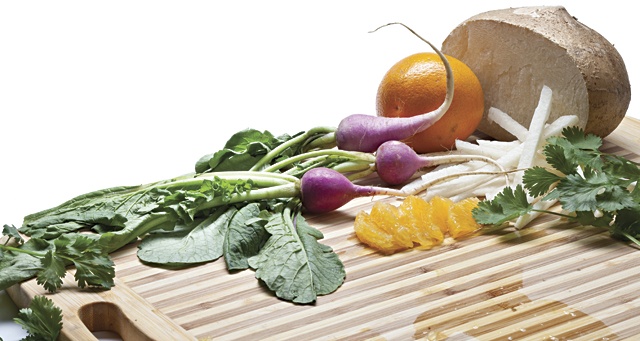When temperatures spike on an August afternoon, who wants to stand over a hot stove making dinner? Not me. I’d much rather be at the cutting board using my knife to create a cool salad, either as the main dinner event or a sideshow.
Salads don’t have to mean an unchanging diet of lettuce, tomatoes and cucumbers. They can be tossed together with a wide array of combinations—vegetables, fruits, cheeses, meats, nuts and seeds—each adding their own flavors and textures. And the possibilities expand with what you use to dress your salad, from a simple vinaigrette to a creamy emulsification.
Summer is the best time to eat fresh fruits and veggies, which are near the peak of their ripeness and flavor. So if the heat’s got you down, try cooling off with salad for supper.
Here’s a nice idea for a salad that’s refreshing and light. It comes from a cookbook filled with fresh ideas on vegetarian cuisine. Michael Natkin’s Herbivoracious (The Harvard Common Press, 2012) contains 150 original recipes combining flavors that work together in unexpected ways. One of these is a side salad that would pair well with a spicy entrée. I could not find Valencia oranges as the recipe called for and substituted naval oranges instead. The results were still quite tasty.
Jicama, Radish and Orange Salad
Half of 1 jicama
1 bunch radishes, trimmed and quartered
4 Valencia oranges, cut into supremes*, juice reserved
1/4 teaspoon kosher salt
Freshly ground black pepper
1 handful torn cilantro leaves, for garnish
- Peel jicama and cut into batons, or strips, that are about 2 inches long, 1/4 inch wide and 1/4 inch deep.
- Combine batons, radishes and orange supremes in a salad bowl with salt and generous grind of pepper.
- Add 1/4 cup reserved orange juice and toss lightly. Taste and adjust seasonings. Garnish with cilantro and serve.
Servings: 4. Serving size: 1/4 salad. Per serving: 75 calories, 1.6 g protein, 0.1 g fat, 18.7 g carbohydrates, 5 g dietary fiber, 151 mg sodium, 13.1 g sugars
*Making a Supreme
A supreme is a segment of a citrus fruit without any pith or membrane. To make supremes, first slice a half-inch off the top and bottom of a fruit. Stand fruit, one cut side down, on a cutting board and use a sharp knife to cut off the peel and pith (white portion), traveling from top to bottom and following the fruit’s contour. When all peel has been removed, hold the fruit over a bowl and slice in on both sides of a segment, as close as possible to the membrane. If segment doesn’t fall right out, a slight twist of the knife should remove it.
When done, sections of fruit should be sitting in juice. Squeeze remaining peel and membrane to extract any remaining juice.
Note: If you are concerned about your knife technique, just use standard segments and squeeze a fifth orange for juice. Please, don’t hurt yourself.
Essential Salad Tools
Sharp Knife After a few uses, even the finest chef’s knives lose their edge. If your tomatoes look more like they’ve been crushed than sliced, consider having your knife professionally sharpened. And employ a honing implement before every use.
Salad Spinner If you’ve ever suffered through a soggy salad caused by greens that were washed but inadequately dried, you’ll agree this kitchen gadget is worth it. It consists of a basket with a mechanism for imparting centrifugal force that whirls away excess moisture, leaving lettuce crisp and dry.
Big Bowl Ever tried to toss a salad in too small a bowl? You probably ended up with more lettuce on the counter than in the container. Use a bowl of adequate size to make mixing easier.
Salad Tongs I love my pair of wooden salad servers that resemble bear claws. They make tossing and serving a breeze.
Old Jar If you like to mix your own dressings, there’s nothing wrong with recycling a glass jar to use as your container. (Just make sure the lid seals tight.)


